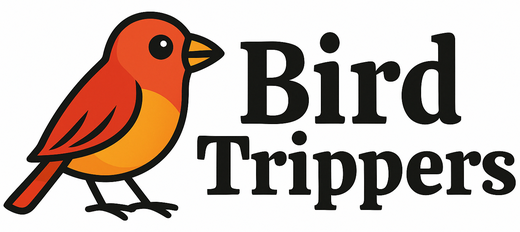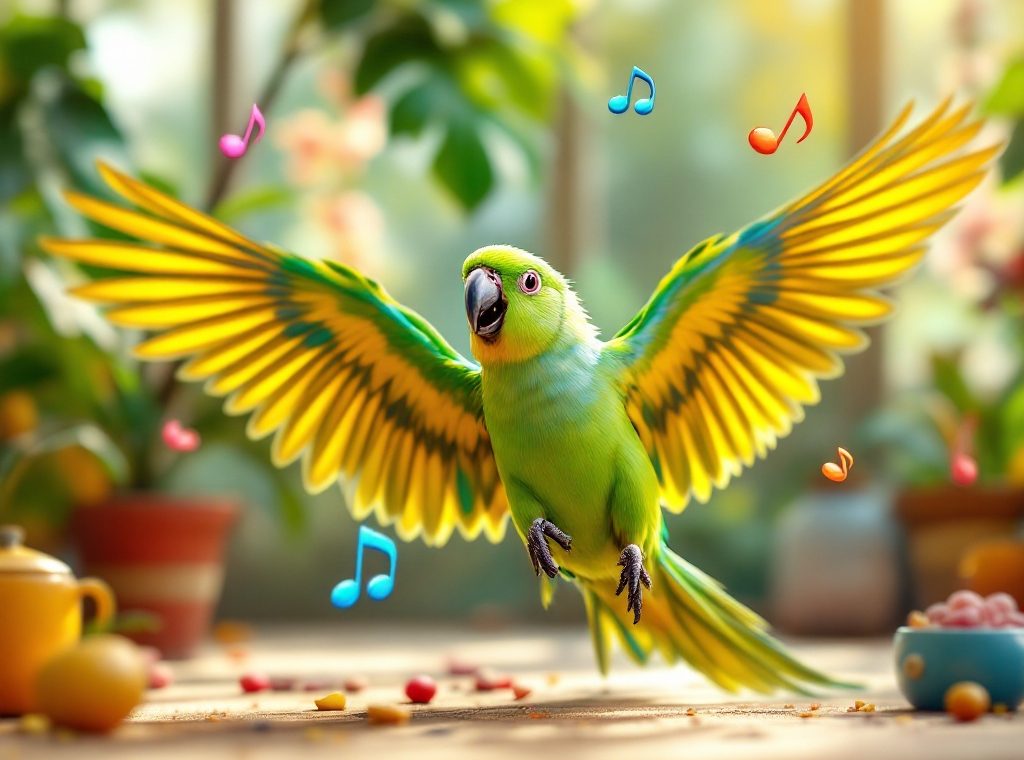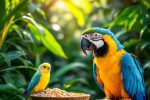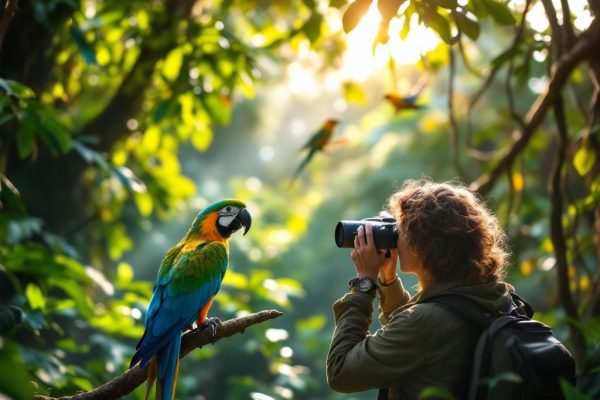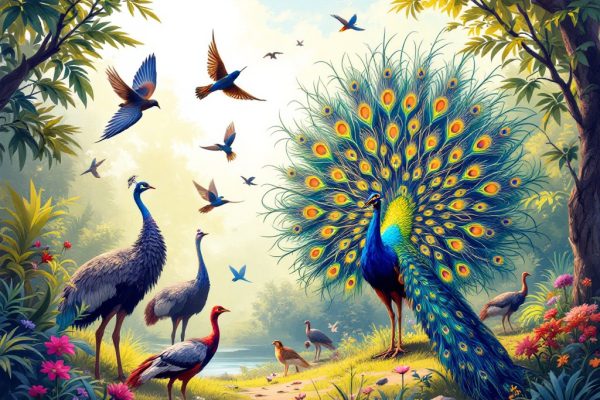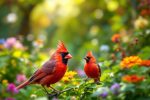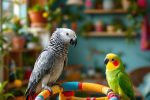Why Do Parrots Dance: The Story Behind Their Moves
Ever witnessed a parrot grooving to the beat? Discover the fascinating science behind why parrots dance, from their innate sense of rhythm and brain structure to how they express joy and bond through movement. Explore the impact of music on parrot behavior, learn training tips to encourage your feathered friend’s dance moves, and delve into the groundbreaking research of Snowball, the dancing cockatoo, who revolutionized our understanding of avian musicality. Uncover the secrets of this captivating connection between parrots and music, and learn how to enhance your bond with your own bird through the power of dance.
Important information
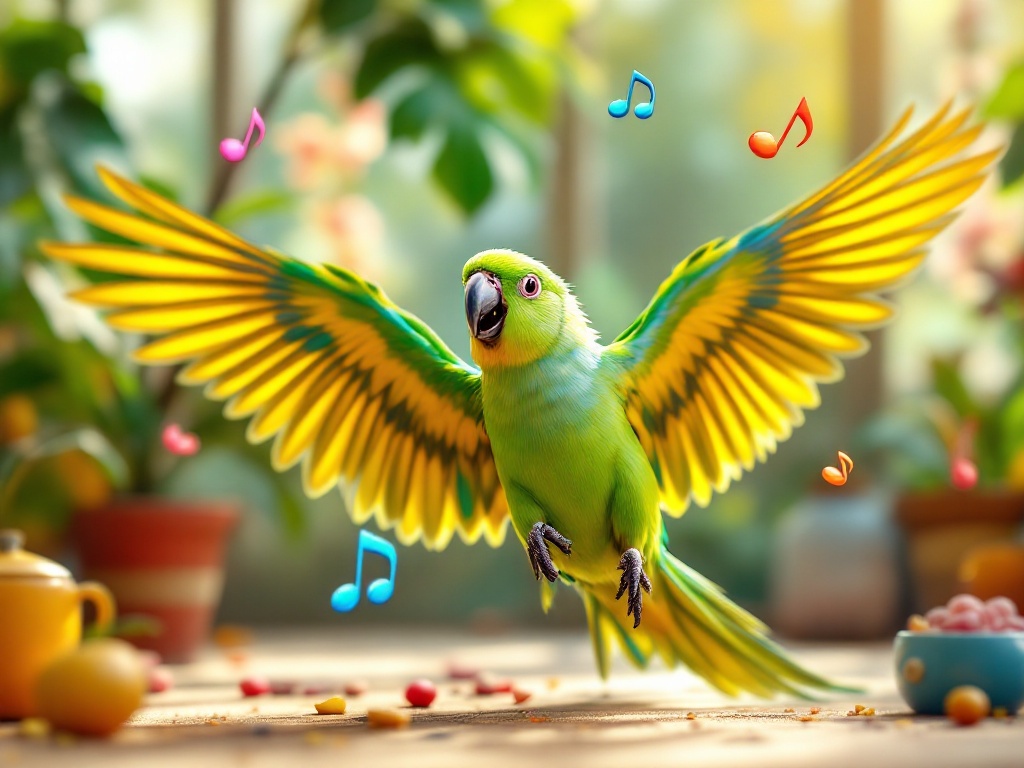
- Parrots dance to express joy, bond socially, and attract mates. Their brains have specialized areas, like the cerebellum and basal ganglia, that help them process rhythm and coordinate movements.
- Music stimulates parrots’ natural instincts to move rhythmically. They often show preferences for certain types of music, especially classical.
- Dancing provides physical exercise, mental stimulation, and stress reduction, contributing to a parrot’s overall well-being.
- While most parrots have an innate sense of rhythm, not all dance. Individual personality, environment, and musical exposure play a role. Positive reinforcement can encourage dancing.
- Research, including studies on the famous dancing cockatoo Snowball, has shown that parrots don’t just mimic rhythm, they anticipate and feel it.
The Science of Parrot Dancing
Parrots’ dances, often inspired by music, are captivating expressions of joy and contentment. These movements provide a natural outlet for their energy and are instinctive behaviors crucial for courtship and play. For pet parrots, dancing offers additional benefits: entertainment, attention-seeking, and bonding with owners. However, not all parrots dance. Individual personality, environment, musical exposure, and species differences can all influence a parrot’s inclination to dance.
What Enables Parrots to Sense Rhythm?
Parrots have an innate sense of rhythm, hearing, feeling, and moving to the beat. This “rhythmic entrainment” comes from specialized brain circuits that process sound and control movement, similar to those in humans and other musically inclined animals. Parrots don’t just perceive the rhythm; they anticipate it, allowing them to perform complex, dance-like movements.
What Role Does Vocal Mimicry Play in Parrot Dancing?
Parrots’ renowned vocal mimicry might actually enhance their dancing prowess, helping them synchronize movements to music’s rhythm. This synchronization is key to rhythmic dancing, and their mimicry—including music—stems from their social nature and communication instincts. Mimicry helps them attract attention, showcase their skills, and strengthen bonds with companions. Music further stimulates their intelligence and playfulness, encouraging expressive dance. It’s fascinating how these abilities intertwine to create such captivating performances.
The Neurological Basis of Parrot Dancing
Parrots are remarkably skilled dancers thanks to key brain regions like the cerebellum and basal ganglia. These areas manage complex movements by processing sensory input, such as auditory rhythms, and converting them into motor commands. The cerebellum ensures precise timing and coordination. The basal ganglia initiate and execute learned movements. This interplay allows parrots not only to grasp rhythmic patterns but also synchronize their bodies to music.
Understanding the Motor Parts of the Brain in Parrots
The cerebellum governs coordination and balance, enabling complex movements such as head-bobbing and wing-flapping. This is essential for motor control. The basal ganglia also play a key role, contributing to the rhythmic timing that allows parrots to dance. Finally, the cerebrum’s motor cortex directs voluntary muscle movements, giving parrots refined control over their dance steps.
How Do Neural Mechanisms Support Parrot Dance?
Parrots have a natural talent for dancing due to their uniquely wired brains. When they hear music, they instinctively move to the rhythm. This remarkable ability is made possible by specific brain regions, similar to those in humans responsible for movement and sound processing. In essence, parrots perceive the beat and translate it into coordinated, dance-like movements.
Understanding Parrot Dance Movements
Parrots are natural dancers, expressing themselves through rhythmic movements like head-bobbing and voguing. These charming displays demonstrate their enjoyment of music as they bob, sway, and even flap their wings to the beat. Individual style varies depending on the parrot and the music, with some adding spins or hops to their routines. This innate behavior is often observed during social interactions, signifying excitement and engagement with their surroundings.
Why Do Parrots Dance?
Parrots communicate a range of emotions through dance, from joy to excitement. It’s a way for them to connect with their world, strengthen social bonds, and interact with both humans and other birds.
Benefits of Dancing for Parrots
Dancing benefits a parrot’s emotional well-being. This natural form of expression encourages physical activity and mental stimulation, leading to a happier, more content bird. The act of dancing can reduce stress, improve mood, and create a positive emotional state that contributes to their overall health and well-being.
Common Dance Moves: Headbobbing, Voguing, and More
Parrots are expressive performers with a diverse dance repertoire. Their moves range from headbobbing and swaying to spinning and flapping their wings. A parrot’s individual personality and energy levels influence their unique dance style, as does the music they hear. Some parrots even invent their own steps, showcasing creativity and self-expression. While headbobbing involves rhythmic up-and-down head movements, other moves, like voguing, incorporate stylized poses and arm movements.
How Parrots Use Dance as a Form of Expression
Parrots dance to express joy and other emotions. Their movements, from head bobbing and swaying to flapping wings, often accompanied by sounds, strengthen their bonds with both fellow parrots and human companions. It’s their way of connecting.
The Connection Between Dance and Emotional Well-being in Parrots
Dancing is essential for a parrot’s well-being, providing both physical and emotional benefits. It’s a fantastic way for them to exercise, keeping their minds sharp and boosting their social skills. Through dance, these expressive birds can communicate and alleviate boredom and frustration, strengthening the bond they share with their owners. A dancing parrot often signifies a content and healthy bird, comfortable in its environment.
Benefits of Dancing for Parrots
- Physical exercise, maintaining mental sharpness, and improving social skills.
- Communication, boredom and frustration relief, and stronger owner-bird bond.
- Indicator of contentment, health, and comfort in their environment.
Reasons for Dancing in Parrots
In the wild: Courtship rituals, social bonding, and displays of health and vitality.
As pets: Enriched social development, improved emotional health, and reinforced connection with human companions.
Physical and Mental Stimulation: Provides an outlet for energy and relieves boredom.
Enhanced Social Interaction: Fosters a sense of community for these intelligent creatures.
Improved Mental Acuity: Contributes to mental sharpness and enhances cognitive function.
Enhanced Mobility and Coordination: Improves physical dexterity and coordination.
Stronger Owner-Bird Relationship: Strengthens the bond and builds trust between parrot and owner.
Prevents Obesity and Provides Mental Enrichment: Helps maintain a healthy weight and provides mental stimulation.
Builds Companionship and Trust: Fosters a deeper connection and strengthens the bond between bird and owner.
Most parrots possess an innate rhythm and social nature that makes them capable dancers. Individual interest and skill can vary based on factors such as their environment, exposure to music, and level of socialization.
Parrots and Music: A Unique Bond
Parrots share a unique bond with music, often favoring particular melodies. This stems from their inherent rhythmic sense. They showcase this musicality through dancing, mimicking tunes, and replicating rhythms. These actions highlight a captivating connection between their auditory perception, physical coordination, and social interaction. Studies suggest that music activates a parrot’s natural instincts, encouraging rhythmic movements and vocalizations. This behavior could indicate communication, playful engagement, or even a sign of intelligence.
Why Do Parrots Enjoy Music?
Music enlivens a parrot’s world, appealing to their innate sense of rhythm and remarkable mimicry. This auditory stimulation resonates deeply, inspiring them to dance and express themselves. It also fosters a stronger bond with their owners. Parrots’ talent for mimicking sounds allows them to engage with music on a deeper level, imitating melodies and rhythms as they dance. This adds another dimension to their enjoyment, further solidifying their connection with music. While each parrot has unique musical tastes, the power of music to encourage rhythmic movement and enrich their social interactions is undeniable.
How Do Parrots Show Musical Preferences?
Parrots demonstrate a fascinating capacity for musical appreciation, exhibiting distinct preferences for certain songs and genres. Classical music, known for its calming yet complex melodies, appears particularly appealing to these avian connoisseurs. This suggests a noteworthy ability to process and respond to diverse musical elements, indicative of a nuanced understanding and enjoyment of sound.
What Types of Music Do Parrots Prefer?
Parrots flourish when exposed to calm, complex music, with classical melodies being a particular favorite. This musical preference influences their dancing and overall mood, often leading to demonstrably happier birds. Individual reactions vary, however, highlighting the need for further research to fully grasp these nuanced preferences in these complex creatures. Music plays a significant role in a parrot’s world.
The Impact of Music on Parrot Behavior
Music profoundly affects parrots, often inspiring joyful dances that enhance their well-being. This rhythmic stimulation taps into their natural instincts, encouraging movement and interaction, which strengthens the bond with their human companions. However, dancing isn’t universal among parrots. Factors like personality, environment, and musical exposure all contribute. A shy bird in a quiet home may not dance, even with music playing, while a parrot raised around melodies is more predisposed to rhythmic movement. Here’s a closer look at how these factors interact:
Personality
Just like humans, some parrots are naturally more outgoing and expressive than others. A bold, energetic parrot is more likely to dance, while a shy or reserved one might simply bob its head or remain still.
Environment
A stimulating environment with plenty of toys and interaction can encourage dancing. A quiet, unstimulating environment might discourage a parrot from expressing its musicality through movement.
Musical Exposure
Early and frequent exposure to music can significantly influence a parrot’s likelihood of dancing. Parrots raised in musical households are more likely to develop an affinity for rhythm and movement.
The Parrot-Human Bond
Dancing can be a powerful way for parrots to bond with their human companions. When a parrot dances to music its human enjoys, it creates a shared experience that strengthens their connection.
Research and Studies on Parrot Dancing
Parrots dance to strengthen social bonds, express excitement, and attract potential mates. This fascinating behavior has caught the attention of scientists, who are studying the connection between music, movement, and parrot well-being. Researchers are particularly intrigued by how parrots perceive rhythm and synchronize their movements to the beat. Snowball, the famous dancing cockatoo, has become a key subject in these studies, providing valuable insights into avian rhythmic abilities. The influence of human interaction and social learning on parrot dance is another area of active investigation.
What Are Scientists Discovering About Parrot Dance?
Scientists are exploring why parrots dance, looking at both brain activity and emotional expression. Studies suggest these birds have a natural sense of rhythm, possibly using dance for social bonding or emotional release. Researchers are studying how dancing affects parrot well-being, with Snowball the cockatoo’s rhythmic skills being a key example.
The Role of Human-Animal Interaction in Parrot Dance
Dancing with Parrots: A Joyful ConnectionMusic plays a vital role in strengthening the bond between parrots and their owners. It inspires enthusiastic dancing, especially when humans join in the fun. With human interaction, parrots develop more intricate and expressive dance moves. Research suggests that these dances are a form of communication, expressing joy and excitement. This behavior is often reinforced by human encouragement, making dancing a learned social activity for parrots. Interacting with humans also exposes parrots to diverse musical genres, enriching their dance repertoire and inspiring new moves. So, turn up the tunes and enjoy the delightful experience of dancing with your feathered friend.
Case Study: Snowball the Dancing Cockatoo
Snowball, the sulphur-crested cockatoo, became an internet sensation with his impressive dance moves. This sparked valuable research into avian musicality and its connection to human rhythm. Researchers discovered that Snowball wasn’t just mimicking; he was truly feeling the beat, synchronizing his body to the music. This suggests a deep link between music and movement in parrots. Scientists altered the music’s tempo to observe how it affected Snowball’s dancing, revealing more about the cognitive abilities of birds.
Training Parrots to Dance
Parrots are natural rhythm enthusiasts and can learn to dance. Their mimicry skills extend to the dance floor. Playing varied tempos and rhythms encourages them to move. When your parrot dances, offer praise or a treat. This positive reinforcement helps them associate movement with rewards. Interactive play, like clapping or swaying, can also get them grooving. They’ll likely join the fun. Experiment with different genres to discover your parrot’s musical preferences and watch their unique dance style emerge. It’s all about tapping into their natural rhythm.
How Can Parrots Be Trained to Dance?
Parrots can learn to dance through positive reinforcement. Rewarding them with treats or praise when they move rhythmically to music creates a positive association, encouraging them to dance more. However, not all parrots will enjoy dancing. Like humans, their musical preferences vary. Some adore music, while others don’t. Each bird’s unique personality also plays a role.
Can Training Enhance a Parrot’s Natural Dance Ability?
Parrots possess an innate rhythmic talent, and with training, they transform into skilled dancers. Through observation and imitation, they learn complex movements, and positive reinforcement such as treats and praise accelerates their learning.
